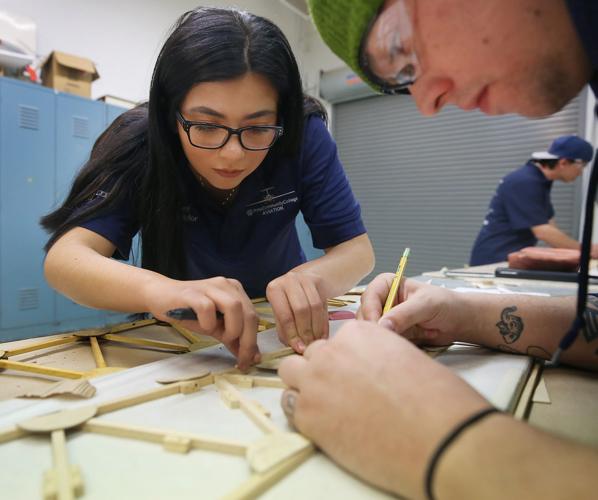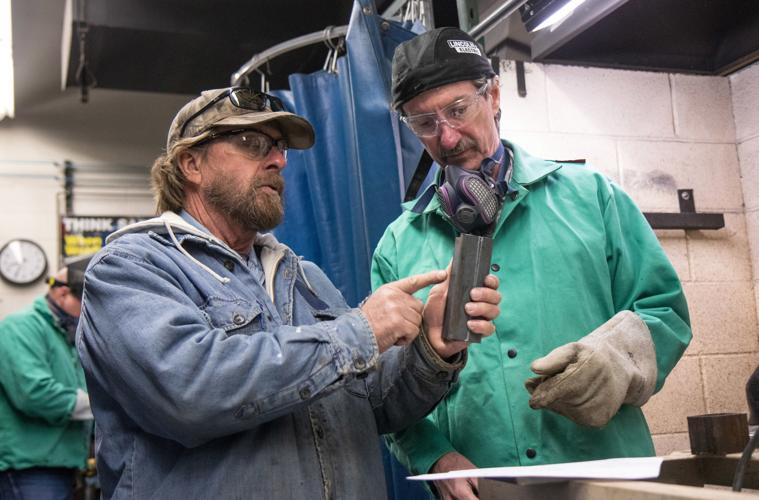Pima Community College has boosted its technology-focused workforce-development programs in recent years, refining course offerings and investing millions of dollars in new, state-of-the art equipment.
Now, Pima is on the verge of a building boom, as it looks to make more space for high-demand programs like aviation maintenance and more than double its pipeline of trained tech workers.
Last year, the Pima College Governing Board and a legislative capital-review committee approved the college’s plan for a new, $45 million Applied Technology Center of Excellence at the Downtown Campus to expand its machining, construction and automotive programs.
More recently, the state budget plan proposed by Gov. Doug Ducey includes $20 million to roughly double the size of Pima’s highly rated Aviation Technology Program at Tucson International Airport.
Plans to expand the aviation-tech program — which has a one-year enrollment waiting list — was proposed years ago but failed to gain traction with the state’s political leadership, said Ian Roark, who was hired as Pima’s vice president for workforce development in 2015.
The state ended direct appropriations to Pima and most Arizona community colleges in 2015, though they still get funding they can use for capital costs from the Proposition 301 sales tax for education approved by voters in 2000.
With the help of aviation industry and local government leaders, Roark aligned the expansion plan with Pima’s new focus on “centers of excellence” that are responsive to industry and community needs.
“We were looking for opportunities to ask for funding, but to make it clear that that funding is going to be aligned with the workforce and economic-development priorities of our state,” said Roark, who said he believes Ducey’s proposal has broad support among lawmakers.
NEW TECH CENTER
Meanwhile, the planned new Applied Technology Center is expected to open more opportunities to develop worker-training programs in partnership with industry, Roark said.
A prime example is a program launched last August that teaches engineers from Caterpillar practical machining and welding skills to help them design equipment for efficient production.
Caterpillar has already moved many staff to Tucson as it nears completion on a new Mining Center downtown, which will eventually house up to 600 executives and high-level engineers.
“One of the things that is crucial about all of this, and we’re seeing it with the Caterpillar program, is those direct partnerships with industry, as community partners,” Roark said.
He also cited Pima’s recent partnership with the Arizona Cyber Warfare Range, a nonprofit dedicated to mentoring a new generation of cybersecurity workers, to open a site at Pima’s East Campus information-tech center.
The head of Tucson’s economic-development agency said such partnerships are critical to persuading companies to move or expand here.
“We have a very low unemployment rate, so the ability to demonstrate that we can fill companies’ labor needs is really paramount,” said Joe Snell, president and CEO of Sun Corridor Inc. “We can recruit them in, but a large portion of this has to be training our people up to be competitive.”
EVOLVING TO MEET NEEDS
Greg Wilson, PCC’s academic dean for applied technology, said the planned new Downtown Campus building will allow the school to train more workers both in custom programs like the Caterpillar classes and its regular tech curricula, which is constantly adjusted to meet the needs of industry.
Like other tech schools, PCC is hearing from employers that they can’t get enough qualified workers. Labor shortages are particularly acute in industries including construction, machining and aviation maintenance, and they are only projected to worsen as aging tech workers retire at a faster clip.
Pima’s Applied Technology programs encompass aviation, automotive, building and construction technologies, computer-aided design, energy, machining, welding and “mechatronics,” a program added in 2017 to combine elements of mechanical and electrical engineering with computer science to teach students to design and maintain automated manufacturing equipment.
“We’re continually improving based on what’s happening in industry,” said Wilson, citing the addition of the mechatronics program and a course on integrated-system design taught by a Raytheon engineer.
Following industry’s lead, Wilson said, PCC also has invested millions of dollars in new equipment, including state-of-the art, computer-controlled milling machines for its machining program and 2018 car models for its auto shop.
PCC is now in a bit of a space crunch at the current science and technology buildings at the Downtown Campus, where the auto, construction and machining programs are all at capacity.
“In our area, we’re just limited by space,” Wilson said, adding that demand is high for all of its programs.
And though PCC has programs linked to local high school classes offered through the Joint Technical Education District, training and retraining of older workers is critical to solving the tech labor shortages, Wilson said.
The new Applied Technology Center is still in its early design phase, but the college is considering a building of 60,000 to 100,000 square feet, said Wilson.
The plan is to move the automotive labs, which now occupy about 10,000 square feet, into the new building to free up more space for construction tech and machining, he said.
AVIATION PROGRAM SOARS
The high demand for qualified tech workers comes into sharp focus at the Aviation Technology Program, which graduates 50 to 60 students per year and has a job-placement rate of nearly 100 percent, said Jason Bowersock, academic director of the aviation-tech program.
The expansion would add a second hangar, five classrooms and offices, roughly doubling the program’s footprint and allowing PCC to double its allowed enrollment to 250 and graduate up to 150 students each year.
“Our students are leaving here with two or three offers — we don’t have any trouble placing these students,” said Bowersock, who joined PCC as an aviation-tech instructor in 2015 after a 20-year career in Air Force maintenance and was named academic director in mid-2016.
Angel Rodriguez, 28, a former Army aviation air-traffic controller, said he liked aviation but had no mechanical skills when he enrolled in the PCC program in 2017.
Now, the Tucson native is set to graduate with an associate’s degree in May and feels like he has his pick of jobs after initial interviews with Boeing, Bombardier and Columbia Helicopters.
After leading base operations in Iraq, Afghanistan and Africa during his Army stint, Rodriguez said he appreciates the leadership skills taught at PCC, which counts several former military members among its faculty.
Another PCC aviation student expecting to graduate in May, 20-year-old Mike Stacy, started in the program through the JTED program at Sabino High School.
He’s talked with Boeing and several other companies and is keenly interested in Hawaiian Airlines because of the experience he could gain working on big, transoceanic airliners.
Stacy gave PCC’s instructors high marks for their hands-on approach and deep subject-matter knowledge and said he isn’t sure why more young people don’t pursue aviation-tech careers.
“They probably worry about the math; I’m good at math so it’s super easy,” Stacy said.
“I think a lot of people don’t want to work with their hands, and that’s what you do a lot here.”
Aviation mechanics can make good money, with pay starting at about $16 per hour and a median 2017 wage of more than $29 an hour, according to federal labor statistics.
Students in PCC’s aviation-tech courses, which include airframe and power plant, structural repair, general mechanics and avionics tracks, pay about $12,000 in tuition for the 19-month course that gives them a certificate and prepares them to take FAA certification exams.
Under separate FAA rules, Roark noted, PCC also offers a fast-track program that trains students like former military aircraft maintainers, who already have aircraft-maintenance experience but lack required FAA certification, to work on commercial aircraft.
The need is staggering. Industry giant Boeing has projected that 189,000 additional technicians will be needed by 2037 to support North America’s commercial and business aviation needs.
Sun Corridor’s Snell said the Pima aviation program is expected to remain a key player as the agency courts several major aerospace companies.
“We have a pipeline full of aviation companies looking at Tucson, and the aviation-tech program is absolutely critical to have chance to win the competition,” he said.
“There probably isn’t a more important partner, as we sit today, than PCC.”






